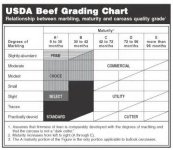Commercial herd here; had a 'stabilized' SimAngus base herd, bred over a 20 year period - but, being a fan of traditional Simmentals, they were mostly red/yellow white-faced, with a few old 'flowery' spotted girls. I was getting hammered at the auction barn on 'em. Went back toward the Angus side of the deal, and made most of them black.
Have some nice 3/4 and higher percentage Angus cows now - most by the walking herdsire; calves by AI Angus sires...just left something to be desired. Farm manager(wife) decided to try infusing some Shorthorn -mainly for the maternal traits. Pleasant surprise was...that the steer calves were head and shoulders above any Angus-sired steers...on par with those sired by Simmental sires.
Will probably be breeding the red cows to black bulls and black cows to Shorthorn sires for the foreseeable future.
Have some nice 3/4 and higher percentage Angus cows now - most by the walking herdsire; calves by AI Angus sires...just left something to be desired. Farm manager(wife) decided to try infusing some Shorthorn -mainly for the maternal traits. Pleasant surprise was...that the steer calves were head and shoulders above any Angus-sired steers...on par with those sired by Simmental sires.
Will probably be breeding the red cows to black bulls and black cows to Shorthorn sires for the foreseeable future.


